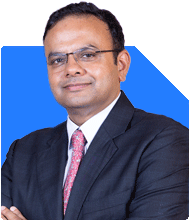Ramalingam Kalirajan |10870 Answers |Ask -Follow
Mutual Funds, Financial Planning Expert - Answered on Jun 21, 2024
He has an MBA in finance from the University of Madras and is a certified financial planner.
He is the director and chief financial planner at Holistic Investment, a Chennai-based firm that offers financial planning and wealth management advice.... more

Hello Sir, I am 33 year old and have started investing in SIPs since last 2 years. I have invested in Mirae Asset Tax saver, Mirae asset Mid Cap, Tata Multicap funds only as of now. Money invested is 80k. Can you please suggest me an approach to build a corpus of 50Lakhs in next 8-10 years. I am currently earning around 1.7 lakhs/month with around 80K expenses/month.
Current Investment Overview
You’ve started well with investments in three mutual funds:
Mirae Asset Tax Saver: This is an Equity Linked Savings Scheme (ELSS), which is tax-efficient.
Mirae Asset Mid Cap: Focuses on medium-sized companies with growth potential.
Tata Multicap Fund: Invests across large, mid, and small-cap stocks.
You’ve invested Rs 80,000 in these funds so far. Each of these funds has its unique benefits, but there’s room to optimize your portfolio to meet your Rs 50 lakh goal.
Setting a Target for Your Goal
To build a corpus of Rs 50 lakhs in 8-10 years, you need a strategic approach. Let’s break down the steps you should consider:
Assess Your Financial Goals:
Define your goals clearly.
How soon do you need the money?
What is your risk tolerance?
Current Savings and Investments:
You’ve started with Rs 80,000.
Let’s build on this base.
Maximize your monthly savings for investment.
Building a Strong Investment Plan
Given your income and expenses, you have a good monthly surplus. Here’s how you can allocate and optimize it:
Increase Your SIP Contributions
Monthly Investment Capacity:
You can invest more since your monthly surplus is Rs 90,000.
Let’s consider gradually increasing your SIP contributions.
Balanced Portfolio:
Diversify into different types of funds (e.g., large-cap, mid-cap, and multi-cap).
This diversification can help manage risks better and optimize returns.
Increase SIPs in High-Performing Funds:
Continue with your current funds but increase the monthly SIP amounts.
Consider adding Rs 10,000 to each of your existing funds and reviewing their performance annually.
Add New Funds:
Introduce a small-cap fund to capture growth in emerging companies.
Allocate Rs 10,000 per month to a new small-cap fund.
Exploring Other Investment Options
While mutual funds are a strong component of your portfolio, consider these additional investments for further growth:
Direct Equity Investments:
Allocate a small portion, say Rs 10,000 per month, to invest directly in the stock market.
Choose stocks from stable sectors with good growth potential.
Debt Funds:
Invest Rs 5,000 per month in debt funds for stability and to balance equity risk.
This provides a safety net and ensures liquidity.
NPS for Retirement Planning:
Contribute Rs 5,000 monthly to the National Pension System (NPS).
This can provide additional tax benefits and long-term growth for retirement.
Optimizing Your Portfolio Performance
Regularly monitoring and adjusting your investments is crucial to stay on track for your goal:
Annual Review:
Review your fund performance annually.
Make adjustments if any fund is consistently underperforming.
Rebalancing:
Rebalance your portfolio to maintain the desired asset allocation.
This involves selling some assets and buying others to keep your portfolio aligned with your risk tolerance and goals.
Staying Informed:
Keep up with market trends and financial news.
This helps in making informed decisions and timely adjustments to your investments.
Managing Risk and Diversification
To achieve your Rs 50 lakh goal with minimized risk, consider these strategies:
Risk Tolerance:
Understand your risk appetite.
Since you have 8-10 years, you can afford to take moderate risks for higher returns.
Diversification:
Diversify across asset classes, sectors, and geographies.
This reduces risk and maximizes returns by not putting all eggs in one basket.
Systematic Investment:
Continue with SIPs to benefit from rupee cost averaging.
This helps in buying more units when prices are low and fewer when prices are high.
Emergency Fund and Insurance Coverage
Before focusing solely on investments, ensure you have these foundational elements in place:
Emergency Fund:
Maintain a fund that covers 6-12 months of your living expenses.
This should be in a savings account or a liquid mutual fund for easy access.
Health and Life Insurance:
Have adequate health insurance for you and your family.
Ensure you have a term insurance policy that provides sufficient coverage.
Tax Planning and Efficiency
Optimizing your investments for tax efficiency is crucial:
Tax-Saving Investments:
Continue with your ELSS investments for tax benefits under Section 80C.
Explore other tax-saving options like NPS and PPF.
Efficient Fund Selection:
Choose funds that provide good post-tax returns.
Equity funds held for more than a year are subject to lower capital gains tax.
Adjusting to Life Changes
Life circumstances can change, and your investment plan should be flexible enough to adapt:
Career Growth:
With potential salary increases, consider increasing your investment contributions.
Aim to save and invest a higher percentage of your income over time.
Family Expenses:
Plan for future family expenses like children’s education and other big-ticket items.
Adjust your savings and investment goals accordingly.
Market Fluctuations:
Stay calm during market volatility.
Stick to your investment plan and avoid making hasty decisions based on market noise.
Long-Term Planning Beyond Rs 50 Lakhs
While your immediate goal is Rs 50 lakhs, consider these aspects for long-term financial health:
Retirement Planning:
Beyond your immediate goal, start planning for retirement.
Consider how much you’ll need to maintain your lifestyle post-retirement.
Wealth Accumulation:
Continue investing beyond reaching your Rs 50 lakh goal.
Building wealth is a continuous process, and longer-term investments can yield substantial growth.
Legacy Planning:
Think about wealth transfer and legacy planning.
Ensure you have a will and estate plan in place to manage and transfer your wealth smoothly.
Final Insights
Your disciplined approach to saving and investing is commendable. By increasing your SIP contributions, diversifying your portfolio, and regularly monitoring your investments, you are well-positioned to achieve your Rs 50 lakh corpus in the next 8-10 years. Stay focused on your goals, adapt to life changes, and continue educating yourself about investments. Your financial journey is a marathon, not a sprint, and your dedication will surely lead to financial success.
Best Regards,
K. Ramalingam, MBA, CFP,
Chief Financial Planner,
www.holisticinvestment.in
You may like to see similar questions and answers below
Omkeshwar Singh | Answer |Ask -Follow
Head, Rank MF - Answered on Sep 15, 2022
Abhishek Dev | Answer |Ask -Follow
Financial Planner - Answered on Aug 28, 2023
Sanjeev Govila | Answer |Ask -Follow
Financial Planner - Answered on Dec 06, 2023
Ramalingam Kalirajan |10870 Answers |Ask -Follow
Mutual Funds, Financial Planning Expert - Answered on Jun 14, 2024
Ramalingam Kalirajan |10870 Answers |Ask -Follow
Mutual Funds, Financial Planning Expert - Answered on Sep 02, 2024
Ulhas Joshi |280 Answers |Ask -Follow
Mutual Fund Expert - Answered on Dec 05, 2025
Dr Dipankar Dutta |1835 Answers |Ask -Follow
Tech Careers and Skill Development Expert - Answered on Dec 04, 2025
Ravi Mittal |676 Answers |Ask -Follow
Dating, Relationships Expert - Answered on Dec 04, 2025
Anu Krishna |1745 Answers |Ask -Follow
Relationships Expert, Mind Coach - Answered on Dec 04, 2025
Anu Krishna |1745 Answers |Ask -Follow
Relationships Expert, Mind Coach - Answered on Dec 04, 2025
Mayank Chandel |2562 Answers |Ask -Follow
IIT-JEE, NEET-UG, SAT, CLAT, CA, CS Exam Expert - Answered on Dec 04, 2025
Mayank Chandel |2562 Answers |Ask -Follow
IIT-JEE, NEET-UG, SAT, CLAT, CA, CS Exam Expert - Answered on Dec 04, 2025
Mayank Chandel |2562 Answers |Ask -Follow
IIT-JEE, NEET-UG, SAT, CLAT, CA, CS Exam Expert - Answered on Dec 04, 2025
Mayank Chandel |2562 Answers |Ask -Follow
IIT-JEE, NEET-UG, SAT, CLAT, CA, CS Exam Expert - Answered on Dec 04, 2025
Mayank Chandel |2562 Answers |Ask -Follow
IIT-JEE, NEET-UG, SAT, CLAT, CA, CS Exam Expert - Answered on Dec 04, 2025



























